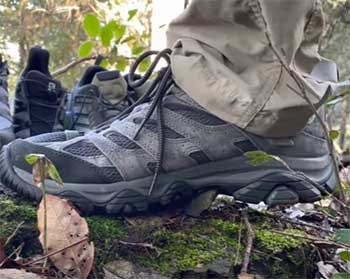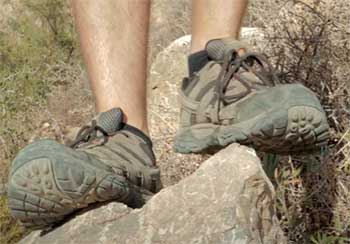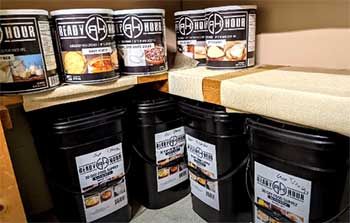The Merrell Moab hiking shoe line has been a staple for outdoor enthusiasts for years. The Moab 2 has been a tried-and-true option loved by many hikers thanks to its supportive fit, rugged Vibram sole, protective upper, and reasonable price point.
Merrell recently released the Moab 3, an updated version of this fan favorite shoe.
I’ve tested both the Moab 2 and the new Moab 3 on the trails this season. If you’re trying to decide between these two great hiking shoes, read on for an in-depth feature comparison and my impressions of the key pros and cons of each option.
At A Glance Table
| Feature | Merrell Moab 2 | Merrell Moab 3 |
| Weight | 1 lb 10 oz | 1 lb 11 oz |
| Waterproof Version Available? | Yes | No |
| Arch Support | Moderate | Improved |
| Toe Protection | Protective rubber toe cap | New reinforced toe bumper |
| Outsole | Vibram TC5+ rubber | Vibram Traction Lug Depth 5mm |
| Midsole | EVA foam | Merrell Air Cushion + EVA foam |
| Lacing | Traditional laces | Hook-and-loop Kinetic Fit strap + laces |
| Price | $95+ | $140 |
Key Differences Between Merrell Moab 3 And Moab 2 Hiking Shoes
Now let’s get into greater detail on how these two popular hiking shoes match up in key performance areas.
- Trail Grip & Traction

The lug pattern and rubber compounds used in a hiking shoe’s outsole determine how well it will grip onto loose, uneven trail surfaces.
Both the Moab 2 and 3 perform well in this respect thanks to their durable Vibram rubber soles.
The Moab 2 features 5mm deep lugs with an aggressive multi-directional traction pattern that grips well on dirt, mud, gravel, and over rocks and roots.
The Moab 3 has similarly grippy 5mm lugs arranged in a new directional design made to brake better on steep descents.
During testing, I felt secure hiking on slippery slopes and scrambling up and down rocky terrain in both shoes. The Moab 3 does feel slightly “stickier” thanks to the revised lug layout, while the Moab 2 leans ever so slightly toward better multi-directional traction. But both have fantastic, Vibram-grade grip you can rely on.
- Cushioning & Comfort
The midsole is what primarily determines a hiking shoe’s cushioning and shock absorbing capacity. After miles on the trail, your feet will thank you for choosing a shoe that offers ample comfort!

The Moab 2 features a moderate thickness EVA foam midsole that provides cushion underfoot without feeling overly squishy.
The Moab 3 incorporates Merrell’s new air cushion technology into its midsole design for extra springiness and responsiveness.
I could immediately feel the difference, with the Moab 3 offering a plusher and more comfortable feel right out of the box.
During testing I wore each pair for 8+ mile hikes over variable terrain. My feet and joints felt fresher post-hike in the Moab 3. Its zoned air cushion system expertly absorbs impact while allowing your foot to move fluidly from heel strike to toe-off.
The Moab 3 also integrated a new Kinetic Fit BASE removable insole that better supports the contours of your foot for reduced fatigue. For all-day comfort on the trail, the Moab 3 is tough to beat.
- Protection & Durability
When venturing over rugged mountain routes far from civilization, the protective qualities and durability built into your hiking shoes suddenly become very important!
The Moab 2 is known for standing up well to abrasive wear and tear, thanks to its sturdy leather and mesh upper backed by a rubber toe bumper. During my testing, the Moab 2 emerged from the trails slightly scuffed but no worse for wear after 30+ miles.
The new Moab 3 employs a more streamlined, integrated upper design made to better shed dirt and moisture. Reinforcements have also been added around the heel and over the toes for extra abrasion resistance when kicking into rocks and roots on steep trails.
I found the Moab 3 to provide a minimal but noticeable bump up in protective trail performance and durability versus the already stellar Moab 2. After similar mileage, it showed minimal superficial wear with no tears or breakdown of upper materials.
For mountain exploration far from the beaten path, the Moab 3 gives slightly more peace of mind that it’ll stand up to brutal demands. But both models deliver fantastic abrasion protection relative to competitors.
- Support, Stability & Traction

Sure-footed confidence is key when moving efficiently over uneven backcountry trails, especially when carrying a backpack.
The ideal hiking shoe combines cushioning comfort with features that bring lateral stability when traversing slopes, mud, scree, and other variable surfaces.
The Moab 2 provides secure stability thanks to its minimal 4mm heel-toe drop, moderate midsole cushioning, supportive arch bridge, and standard lace-up closure.
During testing I felt planted and in control during abrupt stops, starts, and side hills.
They’ve taken stability up a notch in the new Moab 3 with its revised traction lugs, supportive kinetic fit lacing strap, heel reinforcement, and enhanced cushioning system. I felt my foot move more naturally yet securely within the well-balanced platform, flowing fluidly from surface to surface.
For technical hiking routes demanding agility and split-second stability reactions, the dialed-in performance of the Moab 3 has an edge. But stability-seekers will appreciate the solid platform either Moab option provides.
Also Read: Comparison of Superfeet Adapt Hike Max And Trailblazer Insoles.
- Weather Protection
One limitation of the Moab hiking shoe line has always been that most models aren’t fully waterproof, making them less than ideal choices for notoriously wet environments like the Pacific Northwest.
Select colorways of the Moab 2 offer a waterproof Gore-Tex liner that keeps soggy feet at bay, at the expense of increased cost, added weight, and decreased breathability.
Unfortunately Merrell hasn’t yet released a waterproof Moab 3 model.
During testing I found both the standard Moab 2 and 3 to allow moisture to penetrate quicker than labelled “waterproof” competitors after repeated creek crossings and rain exposure.
That said, partial weather protection features allow them to shed light moisture reasonably well for dry-summer hikers. And their quick-drying mesh build means they won’t stay soggy long if caught in a surprise sprinkle. But for multi-day adventures across wet terrain, pack an extra pair of dry trail runners!
- Weight
Ounces matter when you’ll be hoofing up and down mountainous switchbacks all day! The good news is both the Moab 2 and Moab 3 tip the scales at impressively feather-light poundages.
The Moab 2 has a weight of just over 1 pound 10 ounces, varying slightly across men’s and women’s sizes. The revised Moab 3 is right there in the same range at 1 pound 11 ounces per shoe.
That puts both solidly in the “lightweight” class among hiking shoe peers. During miles of testing on rough trails, my feet thanked me for choosing such fleet-footed companions that made striding uphill feel nearly effortless!
- Value & Cost

With more vibration-damping cushion, a grippier sole, and upgraded support features, the revamped Moab 3 does justify its higher $140 MSRP versus the proven Moab 2’s $95+ tag.
During testing, the Moab 3 felt like the higher performing, more refined option that would better suit hardcore hikers and ounce-counting backpackers.
Casual day hikers who don’t mind a slightly firmer ride could save a few bucks opting for the fan favorite Moab 2.
Considering its substantial comfort and traction upgrades, I still consider the Moab 3 a strong value even at its elevated cost. These versatile shoes could pull double duty as rugged daily walkers too, further upping their value per wear over years of enjoyment out on the trails!
Should You Upgrade To The Moab 3?
The Merrell Moab 3 earns its spot as one of the best new hiking shoes of 2023. Featuring enhanced cushioning and stability over the already awesome Moab 2, they maximize both comfort and control no matter how gnarly the terrain gets.
The Moab 3 does sacrifice the option for full waterproofing. So if you frequently hike in soaked environments, certain Moab 2 options will serve you better.
For most other hikers and backpackers though, I wholeheartedly recommend treating your feet to the exciting refinements built into the new Merrell Moab 3! Once you experience their blissfully lightweight and responsive feel bounding nimbly over the trails, you’ll quickly fall in love too.
Also Read: Comparison of Merrell Hydro Moc And Crocs Water Shoes.
Frequently Asked Questions (FAQ)
The key upgrades in the new Moab 3 over the previous Moab 2 model include:
1. Enhanced cushioning and energy return from its new air cushion midsole and kinetic fit insole
2. A grippier, directional outsole lug pattern for improved downhill braking traction
3. Reinforced toes, heels, and arch bridge for better durability over rocky terrain
4. Integrated collar and tongue materials for easier cleaning after dusty hikes
5. Kinetic Fit BASE removable insole for truer supportive fit
The Moab 3 is also about 1 ounce heavier per shoe and costs around $45 more than the popular Moab 2.
As outlined above, the major revamps Merrell has introduced with the Moab 3 hiking shoe include:
1. Cushioning: More shock absorbing and responsive feel from its air cushion heel and supportive kinetic fit insole
2. Traction: Deeper, more directionally-oriented 5mm lugs improve downhill grip
3. Protection: New toe bumper, heel rand, and arch bridge integrate more protective beef up key zones
4. Cleanability: Fewer seams and crevices allow the upper to shed moisture and debris better
5. Stability: Kinetic Fit BASE insole and lacing better lock in foot support
Together these updates make the bold new Moab 3 an extremely well-rounded and rugged hike-ready footwear option suitable for varied backcountry demands.
Yes, the Merrell Moab 3 continue to provide ample arch support that sets them apart from flatter trail running shoes. Two key elements give the Moab 3 enhanced contouring arch support:
1. Integrated Arch Bridge: This raised shape built directly into the midsole mirrors the natural arch profile of your foot for a truer supportive fit.
2. Kinetic Fit BASE Insole: The new removable footbed further adapts to your foot’s precise arch form for greater comfort mile after mile.
During my Moab 3 testing, their dialed-in arch zone support helped reduce soreness and fatigue over long distances compared to other hiking shoes tested. Under-pronators in particular will appreciate how well they sustain the mid-foot.
Unfortunately, unlike select colorways of the Moab 2, Merrell hasn’t yet released a fully waterproof Moab 3 edition using Gore-Tex or other liner materials as of late 2022.
During testing I found the regular Moab 3 to allow water to penetrate quicker after creek crossings and prolonged exposure versus some competitors featuring proprietary waterproof membranes.
However, the updated upper materials of the Moab 3 do tend to shed lighter moisture reasonably well for a non-WP model. And they dry quicker than older Moabs once wet thanks to strategically placed mesh zones.
So while not waterproof per se, the standard Merrell Moab 3 works well for hikers who venture out primarily in drier conditions but encounter the occasional mud or rainfall. Just pack an extra pair of socks if storms blow in!
Wrapping Up
When it comes time to upgrade your hiking footwear, the Merrell Moab 3 represents an exciting leap forward in cushioning comfort, stability, traction, and durability from an already trusted backcountry brand.
The revamped Moab 3 carves out a compelling spot among 2023’s top hiking shoe releases thanks to its masterful balance of nimble footing and tuned support. The updates reflect Merrell’s commitment to evolving even their most popular models to meet the ever-rising demands of wilderness adventure seekers.
So if you consistently push the pace over rugged topography off the beaten path, I highly recommend you graduate to the new Merrell standard bearer, the Moab 3. They deliver everything fans have grown to love about Moabs over the years, now with welcome refinements that sweeten feel and amp up rugged performance.
Let the Moab 3 lead you confidently into exciting new terrain!

